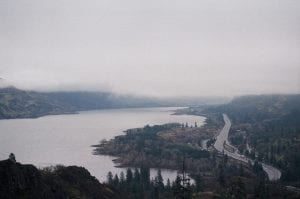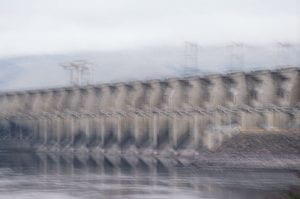Last winter, a Eugene Lang Opportunity Award afforded me the opportunity to travel and undertake research that would culminate in my undergraduate thesis, “Impounded Entanglements: The Dalles Dam, Spatialities of Violence, and the Politics of Infrastructure”. I spent most of January on the territories of Wyam, Chinookan, Yakama, Warm Springs, Umatilla, Nez Perce, and Shoshone peoples—in the states of Washington and Oregon—where I engaged in archival research and familiarized myself with the diverse landscapes and environments—built and natural—of the region. These practices helped me gain deeper understanding of and more nuanced perspective on enduring impacts and histories of infrastructure.
 Over the course of my time researching, I frequently drove up the Columbia Gorge, heading east towards The Dalles Dam. These drives helped me situate the archival materials I studied not only in time but also in place.
Over the course of my time researching, I frequently drove up the Columbia Gorge, heading east towards The Dalles Dam. These drives helped me situate the archival materials I studied not only in time but also in place.
Throughout the spring, I built on the research that I conducted in January. I spent many hours studying the materials I had collected while traveling, while also pulling from my coursework at Lang and conducting further research to develop an analytical frame that would help me articulate what I understood as the significance of the history in which I had chosen to immerse myself. Over the course of the semester, I came to understand my project an endeavor to situate the history of The Dalles Dam in a broad and deep expanse of entanglements.
 It was important to me to see the dam in its present condition, in effort to understand the contemporary impact of its history. In studying promotional materials produced by agencies engaged in dam construction, I found that there was a strong impulse to naturalize built infrastructures as beneficial additions to extant environments. Standing across from the dam, however, I found myself struck by its immensity and the contrast it posed to the languid river waters. My experience of seeing the dam in person encouraged me to be critical of historical materials.
It was important to me to see the dam in its present condition, in effort to understand the contemporary impact of its history. In studying promotional materials produced by agencies engaged in dam construction, I found that there was a strong impulse to naturalize built infrastructures as beneficial additions to extant environments. Standing across from the dam, however, I found myself struck by its immensity and the contrast it posed to the languid river waters. My experience of seeing the dam in person encouraged me to be critical of historical materials.
It became apparent to me that fully accounting for the significance of this history required emplacing it in the context of the settler colonial impositions upon which the United States is founded. It also required drawing out lines of connection between the forms of violence that resulted from the construction of The Dalles Dam, and violences experienced elsewhere—perpetuated by the same agencies and institutions that enacted violence in The Dalles. To elaborate this framework, I drew on the work of many scholars. Kyle Whyte’s description of the ecological impact of settler colonial violence helped me understand the politics of infrastructure in the Columbia Basin. Towards synthesizing the relationship between environmental degradation and settler colonial violence, I found Rob Nixon’s language of “slow violence” also useful. To understand how such violence follows from the expansion of hydropower infrastructures, I took up Henri Lefebvre’s conception of the production of space to distinguish between the different registers in which settler imposition proceeds simultaneously. Working between and through each of these frames, I aimed to position The Dalles Dam on a planet that shifts slightly, evidencing the weight of accumulation.
